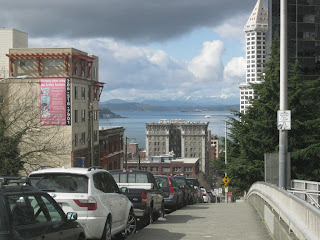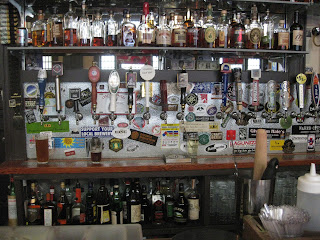Taking Ship
March 20
Greetings, all.
I wrote yesterday’s update over a
breakfast of pancakes and eggs, because I needed to fortify myself for a sea
voyage.
The ferry terminals are close to the
hotel. Turn left as you step out onto the street and go as far as you can, and
then left again for a couple of blocks. Miners Landing, where the Ferris wheel
is, Ye Olde Curiosity Shop, and the aquarium are on the same stretch.
The terminal was full of kids on a
field trip. But the ferry is so big that once we all boarded, I didn’t see them
again until they assembled on the far shore and a lady was giving the
sixth-graders their marching orders.
I was on the 35-minute ride to
Bainbridge Island. The trip brings you closer to the peaks on (I believe) the
Olympic Peninsula. But as the boat pulls away from the Seattle shore, you can
see the mountains on the other side of the city—the Cascade Range. These are
the snow-capped mountains big enough to change the weather. There they were,
looming up in the distance. I had glimpsed some of those peaks from the plane,
but hadn’t caught a view from anywhere I’d visited so far in the city.
As I understand it, the Cascades trap
all the moisture on the coast. Once you get to the other side, the
moderate temperatures of the coastal region are replaced by severe swings over
the year. It can get to be over 100 degrees in the summer. The region is also
much dryer—desert or nearly so.
From the sun deck of the ferry, they
look like the Alps. Of course, this is coming from somebody who has never seen
a single Alp, let alone plurals of them. (I was supposed to see tops of some
Alps a few years ago from the belfry of the Zurich cathedral, but the weather
obscured the view. Sorry, I digress.)
The Cascades were too far off to
catch in a photo. I tried to get some video of the the peaks to the west beyond
the island. It’s probably boring as hell on video. Scenery usually is.
Sometimes people see seals and other marine mammals from the ferries, but not
on this trip.
The headwind on the bow was so hard
it was funny. I had to hold on to my hat. My coat was flapping, and at one
point I was actually taking a half-step back, even though I was sober.
I watched the cars and trucks come
off at the island. It’s amazing what a ferry boat can hold and still float.
Besides all the cars, there were small tractor-trailers and a construction
truck towing a trailer full of materials. I expected to see a tank and maybe a
Space Shuttle.
There was a map of the area posted in
a small park not far from the terminal. There were nature trails marked, but I
couldn’t find them. Maybe that’s where the sixth-graders were going.
There were also historical markers.
Before the gold rush this was logging country, so the island at one time had
the world’s largest sawmill. This was also where the internment of the Japanese
began in 1941. People had to sell their houses and movables and were taken to a
concentration camp in California.
Bainbridge Island is not as built up
as the Seattle side of the sound. There are houses of all sizes on the hills
overlooking the water, but more of the hillside is covered in trees. Downtown
Seattle itself looks like downtown anywhere.
The landing spot on Bainbridge is
largely a commuter point, but there is a small street of gentrified shops
reminiscent of Sag Harbor or Montclair.
I never did find the nature trails,
so I shipped back to Seattle.
The pier next to the ferry terminal
has Ivar’s, which promises “acres of clams.” It was almost three and breakfast
was at 9, so I stopped in for a pint of Manny’s pale ale and a seafood cocktail
that included shrimp and dungeness crab among other good things.
Sea voyage, and sea food, too. What
do these creatures look like before Ivar gets them? I was ready for the
aquarium. I strolled through the drizzle, resisting the allurements of Ye Olde
Curiosity Shop and the attractions of Miners Landing, to buy a ticket.
It was great place to kill an hour or
so out of the rain. There is an alcove in one aquarium where you get to stand
surrounded by fish—coho salmon, something pink, one that glows in the dark.
They come up to the glass to stare back at you. Well, most of them do. The one
that glows is kind of sullen and stays up against the far wall.
I got to see them feed the octopus.
It changes color to a warm brown when it gets excited. The feeder put squid on
a stick and reached down into the tank. Two tentacles came up and played with
the stick for a while and then slipped the squid off. Then the octopus calmed
down, turned gray, and slumped into a mass that is hard to see against the
rocks. A museum staff member said the octopus had been fed a bit of dungeness
crab earlier in the day. So the mollusk and I had the same thing for lunch.
It was a giant Pacific octopus, which
is indigenous to the Puget Sound. There could be one right under out feet under
the pier, the docent said. Wow. What if it has a gun and is coming to break out
its cousin here in the tank? But not to worry, according to the docent,
octopuses don’t much like each other. The aquarium had two and they were held
in separate tanks.
The aquarium also has sea otters, fur
seals, and river otters. All the animals, a sign assured me, were either born
in captivity or rescued injured from the wild. So were the birds. Some were
restored to health and reintroduced to the wild. The permanent residents, like
the one-legged plover, were unfit to be released.
There were small exhibits showing the
habitats of some very colorful animals. Lots of sea anemones and urchins.
Lionfish with the dangerous looking spines. The clownfish lives in the
tentacles of an anemone. It’s mostly bright red, so it’s easy to spot when it
sticks its head out.
This was a color combination I couldn't resist.
At one point you walk under a tank
loaded with coho salmon fingerlings. I was looking up at fish and didn’t have
to hold my breath. I thought the perspective unusual enough to make that the
photo of the day.
By the time I got back up the hill to
the hotel, the rain had tapered off and so had I. I was beat. So I came up to
my room to write most of this, and then stretched out for a quick nap.
After about an hour of that, I had a
novel thought. I’m not even going downstairs to the bar. Maybe I could use a
little drying out. I definitely could use a little sleep.
I turned out the light at 7 and slept
till 5 or so.
Be well all, and remember: hold onto
your hat when you head for the bow.
Harry












